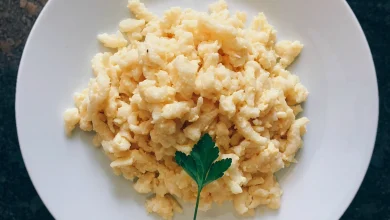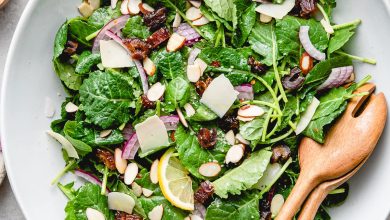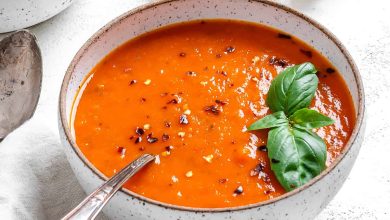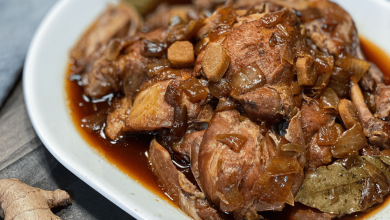Fresh Herb Potato Salad
Fresh Herb Potato Salad is a delightful and versatile dish known for its vibrant flavors and refreshing taste. It’s a classic side dish that’s perfect for picnics, barbecues, or as a light meal on its own. Since you appreciate detailed information and full recipes, here’s a comprehensive overview of Fresh Herb Potato Salad:
History:
Potato salad has a long history, dating back to at least the 18th century. It is believed to have originated in Germany and spread to other parts of Europe and the United States. The addition of fresh herbs to potato salad is a more contemporary twist, adding a burst of fresh flavor to the traditional recipe.
Components:
- Potatoes: Typically, waxy potatoes like Yukon Gold or red potatoes are preferred for potato salad as they hold their shape well after boiling.
- Fresh Herbs: The star ingredients that make this salad special. Common choices include parsley, dill, chives, and tarragon.
- Dressing: A creamy dressing is commonly used, made from mayonnaise, sour cream, or yogurt. You’ll also need Dijon mustard, vinegar, salt, and pepper.
- Other Ingredients: You can customize your potato salad with ingredients like diced red onions, celery, hard-boiled eggs, and even crispy bacon bits for extra flavor and texture.
Steps to Prepare:
-
Boil the Potatoes: Start by washing and scrubbing the potatoes. Cut them into bite-sized pieces. Place them in a pot of cold, salted water. Bring to a boil and cook until they are fork-tender but not mushy (usually around 10-15 minutes).
-
Prepare the Dressing: While the potatoes are cooking, prepare the dressing. In a bowl, combine mayonnaise, sour cream or yogurt, Dijon mustard, vinegar, salt, and pepper. Mix well.
-
Chop the Herbs: Finely chop the fresh herbs (parsley, dill, chives, and tarragon). These herbs will add a burst of fresh flavor to your salad.
-
Assemble the Salad: Drain the cooked potatoes and let them cool slightly. In a large mixing bowl, combine the potatoes, chopped herbs, and any additional ingredients you’ve chosen (like diced onions, celery, or eggs).
-
Add the Dressing: Pour the prepared dressing over the potato mixture. Gently toss everything together until the potatoes are well coated with the dressing.
-
Chill and Serve: Cover the salad and refrigerate for at least an hour to allow the flavors to meld. Serve chilled, garnished with extra fresh herbs if desired.
Time Needed:
- Cooking time for potatoes: 10-15 minutes.
- Preparation of dressing and chopping herbs: 10 minutes.
- Assembling and chilling the salad: 1 hour.
So, in total, you’ll need approximately 1 hour and 25 minutes to prepare Fresh Herb Potato Salad. This includes cooking and chilling time. Enjoy your rich and flavorful potato salad!
Certainly, here are the nutrition facts and health information for Fresh Herb Potato Salad. Please note that these values can vary depending on specific ingredients and portion sizes:
Nutrition Facts (per serving, approximately 1 cup):
- Calories: 220-250 calories
- Total Fat: 12-15 grams
- Saturated Fat: 2-3 grams
- Trans Fat: 0 grams
- Cholesterol: 15-20 milligrams
- Sodium: 250-350 milligrams
- Total Carbohydrates: 25-30 grams
- Dietary Fiber: 2-3 grams
- Sugars: 2-3 grams
- Protein: 2-4 grams
- Vitamin D: 0%
- Calcium: 2%
- Iron: 4%
- Potassium: 8%
Health Information:
-
Moderate Calories: Fresh Herb Potato Salad is moderately calorie-dense, making it a satisfying side dish or light meal option. However, portion control is important, especially if you’re watching your calorie intake.
-
Healthy Fats: The salad contains healthy fats from sources like mayonnaise and sour cream or yogurt. These fats are essential for nutrient absorption and overall health.
-
Protein: While potato salad is not a significant source of protein, the addition of eggs or bacon bits can boost protein content. Protein is important for muscle health and overall body function.
-
Carbohydrates: Potatoes are a good source of carbohydrates, providing energy. The salad also contains some dietary fiber, which aids in digestion.
-
Sodium: The sodium content can vary based on ingredients and seasoning. Be mindful of the salt content, especially if you have dietary restrictions or health concerns related to sodium intake.
-
Vitamins and Minerals: Fresh herbs like parsley and dill contribute essential vitamins and minerals, including vitamin C and potassium. Potatoes are a good source of vitamin B6 and vitamin C.
-
Fiber: The salad offers some dietary fiber, which can promote a feeling of fullness and aid in digestive health.
-
Customization: You can make the salad healthier by using low-fat or Greek yogurt instead of regular mayonnaise and sour cream. Adding more vegetables like cucumbers or bell peppers can increase its nutritional value.
Remember that the nutritional content can vary based on the specific recipe and ingredients used. To make a more accurate assessment of the nutrition, it’s advisable to calculate it based on the exact ingredients and portions you use.








